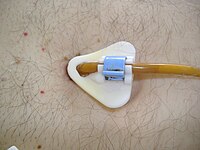
Photo from wikipedia
Background Percutaneous endoscopic gastrostomy is a commonly used endoscopic technique where a tube is placed through the abdominal wall mainly to administer fluids, drugs and/or enteral nutrition. Several placement techniques… Click to show full abstract
Background Percutaneous endoscopic gastrostomy is a commonly used endoscopic technique where a tube is placed through the abdominal wall mainly to administer fluids, drugs and/or enteral nutrition. Several placement techniques are described in the literature with the ‘pull’ technique (Ponsky-Gardener) as the most popular one. Independent of the method used, placement includes a ‘blind’ perforation of the stomach through a small acute surgical abdominal wound. It is a generally safe technique with only few major complications. Nevertheless these complications can be sometimes life-threatening or generate serious morbidity. Method A narrative review of the literature of major complications in percutaneous endoscopic gastrostomy. Results This review was written from a clinical viewpoint focusing on prevention and management of major complications and documented scientific evidence with real cases from more than 20 years of clinical practice. Conclusions Major complications are rare but prevention, early recognition and popper management are important.
Journal Title: BMJ Open Gastroenterology
Year Published: 2021
Link to full text (if available)
Share on Social Media: Sign Up to like & get
recommendations!